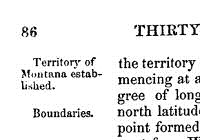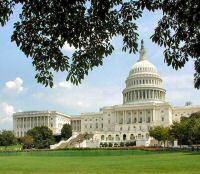 |
THIRTY-EIGHTH CONGRESS
SESS. I CH. 95. 1864
(Get closer) |
STATEHOOD: The United States acquired most of what is now Montana as part of the
Louisiana Purchase of 1803. The northwestern section of the state was gained in a treaty with Britain
in 1846. At various times, parts of Montana were parts of the territories of Louisiana, Missouri,
Nebraska, Dakota, Oregon, Washington, and Idaho.
In 1862, prospectors found gold in Grasshopper Creek in the area now known as southwestern
Montana. At the time, Montana was part of Idaho territory. Other gold strikes followed, and wild
mining camps grew around the gold fields. These camps included Bannack, Diamond City, and Virginia City.
During the boom years, gold dust was the most prominent form of money. Also, during this period, there
was almost no effective law enforcement in the mining camps. Sidney Edgerton, a former U.S.
Representative from Ohio, was appointed United States judge for the Territory of Idaho in 1863. He saw
a need for better government of the wild mining camps.
In 1864, he was persuaded to return to Washington, D.C. to lobby Congress to create a Montana
Territory separate from Idaho. Edgerton had friends on Capitol Hill from his days as an Ohio Congressman
and he agreed to the task. Of course he took about $2,000 in Montana gold nuggets with him to Washington
to impress his friends with the mineral wealth in the new territory. On May 26, 1864, President Abraham
Lincoln signed an act creating the Montana Territory. Sidney Edgerton was appointed as the first
Territorial Governor.
In order to become a state, Montana had to prepare and its citizens had to approve a written
constitution that would have to be accepted by the U.S. Congress. The constitution would contain the
basic laws of the state, the responsibilities of its elected officials, and the rights of citizens of
Montana. Three constitutions were prepared, from 1866-1889, by Montana officials before statehood was
achieved.
Finally, in 1889, the U.S. Congress passed the Enabling Act that allowed Washington, Montana,
North Dakota, and South Dakota to become states. On November 8, 1889, President Benjamin Harrison
issued a proclamation announcing admission of Montana into Union as the 41st state |
| |
|
STATE CONSTITUTION:A constitution sets out the rules by which we play the game of
government. Like the rules for any other game, it limits the moves available to players. It describes how
the various players interact with each other, and who has more power in various situations.
In 1866, Acting Territorial Governor Thomas Francis Meagher, called Montana's first
constitutional convention. Beginning in the cold of December, in a dark dirt-roofed cabin in
Bannack City, legislators spent 60 days putting together Montana's first constitution. The
story goes that this document was lost on the way to the printer in St. Louis....
It wasn't until 1884 that another attempt was made. This time, the convention was held
in Helena. From January 14 through February 9, lawmakers hammered out a
new constitution.
Voters approved it on November 4, 1884. Unfortunately, the U.S. Congress, immersed in political
conflict and worried about the balance of power in the legislature, virtually ignored Montana's
new petitions for statehood.
The political atmosphere in Washington changed, however, and in 1889,
Montana refurbished the 1884
constitution and put it to a vote. Montanans approved it by an overwhelming majority on October 1,
1889. This time, Congress passed an enabling act allowing Montana to become a state.
Recognizing that the 1889 constitution had not aged well, Montanans called for a
Constitutional Convention in 1972. The
1972 constitution, in effect today, is one of the nation’s
most progressive documents. It advocates single-member legislative districts, open-meeting requirements,
and the care and protection of the environment.
PREAMBLE:We the people of Montana grateful to God for the quiet beauty of
our state, the grandeur of our mountains, the vastness of our rolling plains, and desiring to improve the
quality of life, equality of opportunity and to secure the blessings of liberty for this and future generations
do ordain and establish this constitution.
[ MONTANA CONSTITUTION ] |
| |
|
STATE MOTTO:Like other state mottoes, Montana's Spanish Oro y Plata was conceived
as the Montanans were deciding on an official seal for the new Montana Territory. In 1865, shortly after
Montana had gained territorial status, a committee, chaired by Mr. Francis R. Thompson, got together to
determine an appropriate design for the new seal. The committee agreed that the seal should incorporate
certain essential elements of Montana's economy and its future.
As the committee discussed the new seal the question of a territorial motto was introduced. Based
on the mineral wealth that Montana had produced since 1862, members favored "Gold and Silver" as a
meaningful motto for Montana Territory. Someone thought the motto would have a nice ring in Spanish
and, again, there was agreement. Seal design and motto were presented to the Legislature on February
4, 1865. At this time there was a suggestion that "El Dorado," meaning "the place of gold," might
be more appropriate than simply "Gold and Silver." But both houses approved the seal with the motto
Oro y Plata and Territorial Governor Sidney Edgerton signed the bill into law on February 9,
1865.
The seal has been modified, to some degree, over the years, but the motto has remained: Oro y Plata. |
| |
|
STATE GOVERNMENT:As in the case of the federal government, Montana's state government is
organized into three branches - legislative, executive, and judicial. The state government is a product of
three documents: the United States Constitution, the Montana State Constitution, and laws of the state. The
state of Montana voted, in 1992, to impose term limits on their elected representatives. Proponents of the
idea argued that term limits would take government out of the hands of “career politicians” and encourage
more citizens to run for office. Montana term limits state that certain officials may not seek re-election
if they have held an office for eight years in any 16-year period. An official can still be re-elected by
write-in vote, even after serving 8 years in a 16-year period.
The Governor is the top official in the Executive Branch of Montana State government. The
1992 Constitutional initiative enforces term limits for the Governor, the Lieutenant Governor, the
Secretary of State, the State Auditor, the Attorney General, and the Superintendent of Public
Instruction.
The Montana Legislature is composed of a Senate and a House of Representatives. The
1992 Constitutional initiative enforces term limits for state representatives and state senators.
The highest court of appeals in Montana is the state Supreme Court, which consists of one
chief justice and six associate justices--each elected to eight-year terms. The trial courts for major
civil and criminal cases are the state's 20 district courts. These jurisdictions are presided over from
one to four judges, each elected to a six-year term. Municipal courts, police courts, and
justice-of-the-peace courts handle less serious cases.
[ GREAT SEAL OF MONTANA ]
[ MONTANA STATE FLAG ] |
| |
 |
Governor Stephen Clark "Steve" Bullock
Courtesy of the
State of Montana |
GOVERNOR:Stephen Clark "Steve" Bullock (Democrat)
FIRST LADY:Lisa Downs Bullock
[ GOVERNOR'S PAGE ]
[ FORMER STATE GOVERNORS ]
[ ORIGINAL GOVERNOR'S MANSION ]
|
| |

Montana State Capitol Building |
MONTANA CAPITOL BUILDING:
Location:Helena
Date Erected:1899-1902
- Iowa architects, Charles E. Bell and John H. Kent relocated to Helena to meet the legislature’s demand that the capitol architect be a state resident.
- Completed in 1902, the building cost about $485,000 furnished.
- Faced with Montana sandstone, the Capitol was constructed in the Greek neoclassic style.
- The dome, covered with copper, rises 165 feet and is topped with a bronze statue of Lady Liberty.
- In 1912, two wings, faced with Montana granite, were added at a cost of $500,000.
[ HISTORY ]
[ TIMELINE HISTORY ]
[ TOUR ]
[ PURCHASE Montana's State Capitol: The People's Pride ] |
| |
| STATE REPRESENTATION:The Montana Legislature is composed of
two parts, called houses, like the United States Congress. The two parts are the Senate and the House
of Representatives. The Legislature is referred to as a bicameral body because it is made up of two houses.
The Latin roots of the word bicameral, "bi" and "cameral," mean two chambers or rooms. The Legislature
is responsible for making the laws in Montana and for raising and distributing the money necessary to run the
state government. As established by the 1972 Montana Constitution, sessions take place every odd-numbered
year and last for a maximum of 90 legislative days.
[ MONTANA LEGISLATURE ]
[ MONTANA LEGISLATOR SALARIES ] |
| STATE REPRESENTATIVES:Representatives in Montana each represent
people in a specific area of the state. These areas are called house districts. There are currently 100 men
and women representing 100 house districts in the Montana House of Representatives. 53 representatives are
Republicans and 47 are Democrats. Each representative serves for a period of two years in the House of
Representatives, after which he or she must run for re-election. Representatives may not run for re-election
if they have served for eight years in any 16-year period. Representative may exceed these limits if
elected by write-in vote.
[ STATE REPRESENTATIVES ]
[ LEGISLATIVE DISTRICTS ] |
STATE SENATORS:Senators in Montana each represent people
in a specific area of the state. These areas are called senate districts. There are currently 50 men and
women representing 50 senate districts in the Montana Senate. 29 representatives are Republicans and 21 are
Democrats. Each senator serves for a period of four years in the Senate, after which he or she must run for
re-election. Senators may not run for re-election if they have served for eight years in any 16-year
period. Senators may exceed these limits if elected by write-in vote. Half of the Senate membership comes
up for re-election every two years.
[ STATE SENATORS ]
[ LEGISLATIVE DISTRICTS ] |
|
| |
|
LEGISLATIVE PROCESS:The legislative branch of government is responsible for making and
maintaining laws within their jurisdiction. United States representatives and senators, federal legislators,
are responsible for laws at the national level and state legislators are responsible for laws at the state
level. A law begins as an idea that is introduced in the Montana Legislature as a bill by one or more
legislators. The bill then goes through the legislative process to become a law. During this process the bill
may be changed. Not all bills become law.
[ LEGISLATIVE PROCESS ]
[ HOW A BILL BECOMES LAW IN MONTANA ] |
| |
| CURRENT LEGISLATION:When the legislature is meeting, it is said
to be "in session." Legislative sessions occur every odd-numbered year, beginning at noon on the first Monday
in January, with the exception that if the first Monday is January 1, the Legislature then begins on the first
Wednesday of January. The length of a regular session is 90 legislative days. Sessions may be extended if
required to complete the work of the Legislature. In addition, under unusual circumstances, the Legislature
may be called into Special Session by the Governor to deal with a specific problem. The following link will
allow you to look at bills that are currently going through the legislative process.
[ CURRENT LEGISLATION ] |
| |
| STATUTES:The following link will allow you to look at
Montana's current laws.
[ MONTANA CODE ANNOTATED 2003 ] |
| |
| COUNTIES:The United States Constitution does not define local government.
Instead, this function is left up to the states.
Counties are a local unit of government within a state. All but two of the states are divided into
counties. Alaska is divided into boroughs and census districts and Louisiana is divided into parishes where
governing responsibilities are similar to counties.
Traditionally, counties performed tasks mandated by the state, such as property assessment, property and vital
statistic record keeping, maintenance of rural roads, administration of local election and judicial functions,
and support of the poor. Today, counties may be responsible for these functions, more or less, but the
responsibilities of county governments vary from state to state.
| COUNTY TRIVIA:
- Montana is divided into 56 counties
- The largest county in Montana is Beaverhead County at 5,543 square miles.
- The smallest county in Montana is Butte-Silver Bow County at 718 square miles.
- The greatest number of people, 129,352, live in Yellowstone County (2000 Census).
- The least populated county is Petroleum County with 493 residents (2000 Census)
[ ABOUT COUNTY GOVERNMENT ]
[ MONTANA COUNTIES ]
[ MONTANA ASSOCIATION OF COUNTIES ]
[ ASSOCIATION OF U.S. COUNTIES ]
[ US CENSUS BUREAU ]
[ MONTANA MAPS ] |
|
| |
 |
United States Capitol Building
Washington, DC |
U.S. CONGRESSIONAL DELEGATION:
The legislative branch of the United States government makes laws for our nation and raises and distributes
money to run the United States government. The most evident part of the legislative branch is the United
States Congress. Congress is divided into two parts, called houses. The two parts are the Senate and the House
of Representatives. Congress is referred to as a bicameral body because it is made up of two houses. The Latin
roots of the word bicameral, "bi" and "cameral," mean two chambers or rooms. Members of the Senate are called
Senators and members of the House of Representatives are called Representatives. Senators and representatives
serving in these two bodies are sometimes referred to as congressmen, or women, and sometimes as legislators
because their business is to legislate or make laws. The role of the legislative branch is defined in the
United States Constitution.
[ THE UNITED STATES CONSTITUTION ]
Each state elects people to represent them in the United States Congress in Washington, DC. The citizens of each
state elect two senators to represent them in the Senate. They also elect representatives to represent them in
the House of Representatives. The number of representatives each state sends to the House of Representatives
is not a specific number like the Senate, but is based on the population of the state. The people, that are
elected to represent the state's citizens in the United States Congress, are referred to as the congressional
delegation.
There are 100 senators in the U.S. Senate. Each is elected to a term, in the Senate, of six years. There are 435
representatives in the U.S. House of Representatives. Each is elected to a term, in the "House," of two
years.
The citizens of Montana elect two people, like every other state, to represent them in the Senate
and one person, based on Montana's population, to represent them in the House of Representatives.
| U.S. House of Representatives (1): |
|
|
| |
|
broken links to us. We really appreciate it. |
Source: State of Montana Web Site, (http://www.state.mt.us), April 24, 2004
Source: Office of the Governor of Montana, (http://governor.mt.gov/), January 28, 2005
Source: Montana Legislature, (http://leg.state.mt.us/css/), April 24, 2004
Source: Montana Historical Society, (http://www.his.state.mt.us/default.asp), April 24, 2004
Source: National Association of Counties, (http://www.naco.org/), April 24, 2004
Source: National Governor's Association, (http://nga.org/), April 24, 2004 |

 |
|
|
[ HOME
|| INTRO
|| SYMBOLS
|| ALMANAC
|| ECONOMY
|| GEOGRAPHY
|| STATE MAPS
|| PEOPLE
|| GOVERNMENT
]
[ FORUM
|| NEWS
|| COOL SCHOOLS
|| STATE QUIZ
|| BOOK STORE
|| MARKETPLACE
|| STATE LINKS
]
|| GUESTBOOK
|| CONTACT US
|| PRIVACY STATEMENT
] |
Site designed exclusively for NETSTATE.COM by NSTATE

NETSTATE.COM is a Trademark of NSTATE, LLC.
Copyright © 2003- by NSTATE, LLC. All rights reserved.
No copyright is claimed on non-original or licensed material.
Support NETSTATE
Top |
|



